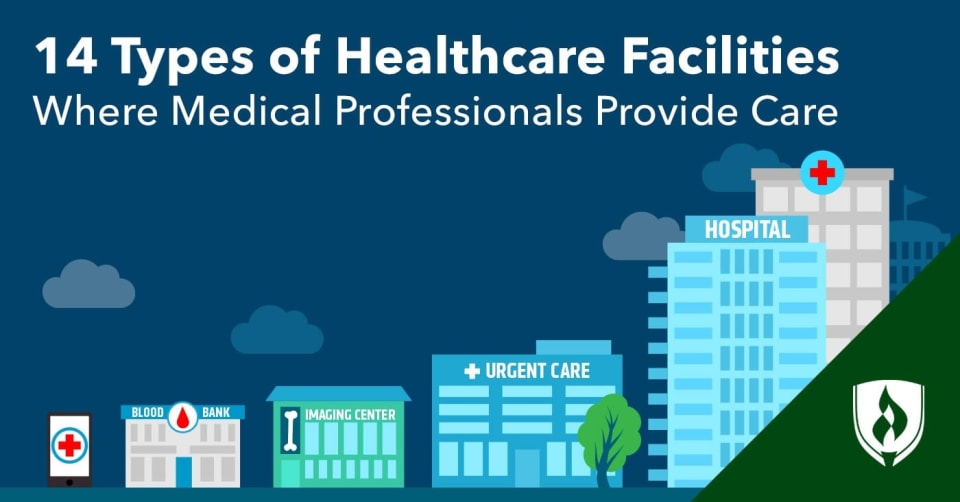14 Types of Healthcare Facilities Where Medical Professionals Provide Care
By Brianna Flavin on 02/20/2018

If you say you work in a healthcare facility, most people think of a hospital or clinic—but even a brief look at the healthcare industry will show there’s a lot of options out there that might not be on the top-of-mind.
As more people seek accurate, holistic and cost-effective care, the healthcare industry is opening new options and expanding its reach. Specialized clinics and outpatient centers have appeared to help ease the burden on hospitals, and more long-term care facilities are rising up to accommodate patients who need months or years of assisted healing.
Many people don’t think twice about these facilities unless they need them. But healthcare is a hot career destination for many, and it’s good to know more about the facilities you may end up working in if you choose to pursue a healthcare career. So let’s take a closer look at some of the most common settings you may work in as a healthcare professional.
14 Types of healthcare facilities commonly found in the U.S.
1. Ambulatory surgical centers
Ambulatory surgical centers, also called outpatient surgical facilities, allow patients to receive certain surgical procedures outside a hospital environment. These environments often offer surgeries at a lower cost than hospitals while also reducing the risk of exposure to infection—since patients are there for surgery, not to recover from sickness and disease.
Ambulatory surgical centers don’t provide diagnostic services or clinic hours. Instead, they take patients who have been referred for surgery by a hospital or physician—they’re designed to be “all business” when it comes to surgical care.
2. Birth centers
A birth center is a healthcare facility for childbirth that focuses on the midwifery model, according to the American Association of Birth Centers. They aim to create a birth environment that feels more comfortable to the mother and allows for a cost-effective, family-inclusive birth.
Birth centers are not typically equipped with the same contingency equipment and staff as a hospital, such as surgeons in case of a C-section or a neonatal intensive care unit. As a result, birth centers accommodate only healthy pregnancies without any known risk or complication factors.
These facilities are guided by principles of prevention, sensitivity, safety, cost-effectiveness and appropriate medical intervention when needed.
3. Blood banks
Blood banks allow donors to donate blood and platelets while also storing and sorting blood into components that can be used most effectively by patients.
“Red blood cells carry oxygen, platelets help the blood clot and plasma has specific proteins that allows proper regulation of coagulation and healing,” writes the American Society of Hematology. Sometimes patients need these particular components specifically, and sometimes they just need lots of blood. For example, a single car accident victim could require as many as 100 pints of blood.
Blood is essential for human life, and it can’t be manufactured—only donated. So these facilities work to build the supply for patients who need it.
4. Clinics and medical offices
The definition of a clinic is “a facility for diagnosis and treatment of outpatients.” There are many healthcare facilities that fit that definition across a wide variety of treatment specialties.
Many people go to a clinic for routine doctor’s appointments and checkups. These healthcare facilities can be a physician’s private practice, a group practice setting or a corporately owned clinic that may be connected to a larger healthcare system or hospital.
Clinics cover a lot of ground in healthcare. For example, you could visit a dental clinic to have a toothache investigated, a physical therapy clinic to recover from an athletic injury or a pediatric speech therapy clinic to help your child overcome an articulation disorder.
If there is a specialized health area you need to see an expert for, then odds are that there’s a clinic somewhere to accommodate you. The goal of these clinics is to give people preventative care and important diagnoses with as much convenience as possible.
That goal has also led to “walk-in” clinics becoming situated in grocery and convenience stores, malls and even airports. These clinics allow patients to get a flu shot or receive a prescription without making an appointment at their physician’s office. While many medical providers believe that a continued relationship with a provider is better for patients’ long-term health, the speed, convenience and sometimes lower cost of a walk-in clinic can be ideal for a quick need.
5. Diabetes education centers
Diabetes is a very serious illness in the United States. Over 30 million people have diabetes and many of them don’t know it, reports the Centers for Disease Control (CDC). Additionally, over a third of the national population is highly at risk for diabetes, in a condition called prediabetes.
Patients with diabetes need to manage the disease and typically make lifestyle adjustments to keep it from becoming life-threatening. Since diabetes is so widespread, diabetes education centers rose up to help patients manage their disease and to help people at risk for diabetes to avoid it, if possible.
Diabetes education centers typically offer classes, education, support groups and a variety of resources to help patients manage their diabetes and live as complication-free as possible.
6. Dialysis Centers
Patients with kidney disease often need regular treatments of dialysis. Dialysis is a process that filters and cleans the blood artificially—the work functioning kidneys normally take on. About 14 percent of Americans have chronic kidney disease. When kidneys aren’t able to filter the blood the way they are supposed to, patients might need dialysis as often as three times a week to avoid serious complications. With such high demand, dialysis facilities rose up to meet patient needs and avoid undue strain on hospitals.
7. Hospice homes
Hospice can be a particularly confusing title. It represents a package of insurance benefits that deals with an end-of-life trajectory. It also represents a philosophy of care provision for dying patients as well as official networks that offer hospice care. Hospice is also a designation for specific healthcare facilities that specialize in end-of-life care.
Hospice care is a model that provides not only medical support, but also emotional and even spiritual support for patients and their families. According to the National Hospice and Palliative Care organization, a patient with hospice care has a team of care providers made up of the patient's personal physician, a hospice physician, nurses, home health aides, social workers, clergy or other counselors and physical or occupational therapists, if needed.
Though patients can receive hospice care at home, if their medical needs are significant, they might live in a nursing home with hospice care, or a specified hospice home.
8. Hospitals
Hospitals are the ultimate “catch-all” healthcare facility. Their services can vary greatly depending on their size and location, but a hospital’s goal is to save lives. Hospitals typically have a wide range of units that can be loosely broken into intensive care and non-intensive care units.
Intensive care units deal with emergencies and the most serious illnesses and injuries. Patients with imminently life-threatening problems go here.
Non-intensive care units include things like childbirth, surgeries, rehabilitation, step-down units for patients who have just been treated in intensive care and many others. Typically, most hospital beds could be classified as non-intensive care.
9. Imaging and radiology centers
These facilities, much like their hospital counterparts, offer diagnostic imaging services to patients. Diagnostic imaging includes CT scans, ultrasounds, X-rays, MRIs and more. While hospitals and even clinics have imaging centers, outpatient facilities help keep costs lower and allow more convenient scheduling for patients.
Hospital facilities will likely handle imaging for urgent cases, such as an MRI for a brain injury. But any imaging that can be scheduled in advance, such as ultrasounds to monitor a pregnancy, could take place at an imaging center.
10. Mental health and addiction treatment centers
This type of healthcare facility is a grouping for many different types of facilities. Specialty treatment centers exist all across America for specified mental health issues and addictions.
Mental health treatment facilities sometimes exist as a general institution for any mental health issue and are sometimes specialized. Examples of these kinds of facilities are suicidal thoughts (or suicidal ideation) treatment, depression treatment, trauma and post-traumatic stress disorder (PTSD) treatment, treatment for anxiety disorders, behavioral disorders and more.
You can find inpatient or outpatient versions of many mental health facilities, designed to assist patients through different stages of their healing processes. At the acute-care level, you can find mental health wards in hospitals—as well as hospitals specifically devoted to mental health and long-term care facilities.
Addiction treatment centers typically deal with drug and alcohol addictions, as well as problematic behavioral addictions like gambling, work, shopping or the internet.
11. Nursing homes
Nursing homes offer a living situation for patients whose medical needs aren’t severe enough for hospitalization, but are too serious to manage at home. Some nursing homes offer services for heavier medical needs, such as speech and occupational therapy. Other nursing homes try to create a homier atmosphere, and might operate like an apartment complex with medical staff on hand.
According to the National Care Planning Council (NCPC), nursing homes enable patients with injuries, acute illnesses or postoperative care needs to recover in an environment outside the hospital. These facilities offer long-term medical care ranging from simple to complex levels of need in an environment built for residents to live in long term instead of just staying a few weeks or months.
Many people picture elderly patients in a nursing home. For the most part that’s true—over 80 percent of patients are over the age of 65. But there are also younger patients in nursing homes who may have serious long-term illnesses and need care beyond what their families can provide.
12. Orthopedic and other rehabilitation centers
Orthopedic medicine deals with muscles and bones. Physical therapists are typically the practitioner patients see for problems in these areas of the body. If you are experiencing chronic lower back pain, for example, you might see a physical therapist at an orthopedic center or clinic to get a diagnosis and a plan of treatment.
Orthopedic centers deal in everything from athletic injuries to therapy for patients with disabilities. They typically offer evaluation and diagnosis of the problem, as well as prevention, treatment and rehabilitation work involving bone, tendon, ligament, muscle and joint conditions.
These healthcare facilities have a variety of names depending on their specialization. They might simple be called outpatient physical therapy centers. Or you could find pediatric physical therapy clinics, sports medicine centers or geriatric physical therapy clinics.
There are also rehabilitation centers where patients can receive various therapies to help restore their abilities after an illness or injury. Physical therapy, occupational therapy and speech therapy are all processes that help people gain or regain skills they need to move around, work or speak in daily life.
Practitioners at rehabilitation centers work with people to help them recover as much of their mobility and independence as possible. Outpatient rehab centers can relieve the strain on hospital rehabilitation floors.
13. Urgent care
Urgent care (UR) facilities exist for on-demand healthcare needs that aren’t severe enough for the emergency room, but are too severe or concerning to wait for a scheduled appointment at the doctor’s office. Urgent care is a common choice when children get sick, for example, and need an immediate diagnosis or relief from symptoms.
Providers in the UR are experts in acute care. They can set broken bones and treat limb fractures; diagnose a viral illness; run strep tests, blood tests and urine labs and provide treatment for injuries. If a problem is too severe, then urgent care practitioners will call an ambulance or refer patients to a hospital or specialist.
14. Telehealth
While telehealth isn’t really a type of healthcare facility, it is worth mentioning in its potential for serious growth in the coming years. Telehealth, telemedicine and remote healthcare can represent a digital type of healthcare facility.
Telehealth refers to the use of electronic communication technology to facilitate long-distance health care and health education, according to the federal Health Resources and Services Administration (HRSA). Many people lack easy access to physicians and specialty clinics. Whether through their physical location, physical ability, living situation or transportation choices, many patients have a hard time getting to a medical practitioner face to face.
Those patient limitations, the push to lower costs in healthcare, and new technological capabilities have all come together to motivate telehealth applications. This might look like live video conferencing between patient and physician. Or a patient with an illness might wear a device to allow remote monitoring from their medical team.
For quick consultations, telehealth can be an ideal option even for patients with easy access to their doctors. “When you log into a web-based service, the doctor or nurse practitioner can prescribe medications, suggest home care strategies or recommend additional medical care,” the Mayo Clinic writes.
And so much more...
As you can see, healthcare represents a massive effort of many different professionals and organizations. And these types of healthcare facilities are only the beginning! Maybe you can even think of a few that aren’t included on this list.
All the different healthcare facilities also offer a huge range of choices for job seekers. If you are interested in a healthcare career, you have plenty of options even at the entry level. For a sampling of the opportunities available, check out our article, “11 Entry-Level Healthcare Jobs Employers Want to Fill NOW.” Also, check out some customer service skills in healthcare you might already have and why they're important.
Check out the benefits of working a holiday in healthcare.
Related Articles:
- Medical Secretaries: Everything You Need to Know About This In-Demand Healthcare Career
- What They Don't Tell You in the Physical Therapist Assistant Job Description
- 20 Healthcare Apps Everyone Should Have
- Tales From the Shift: Brave Healthcare Pros Share Scary Hospital Stories
- What Healthcare Pros Should Know About the Senate Health Committee's Mental Health Reform Bill
- The No-Nonsense Health Pro's Guide to Anti-Inflammatory Diets




